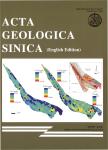Late Cretaceous Adakitic Granites of the Southeastern Tibetan Plateau: Garnet Fractional Crystallization of Arc-Like Magmas at the Thickened Neo-Tethyan Continental Margin
Late Cretaceous Adakitic Granites of the Southeastern Tibetan Plateau: Garnet Fractional Crystallization of Arc-Like Magmas at the Thickened Neo-Tethyan Continental Margin作者机构:Department of Earth SciencesKunming University of Science and TechnologyKunming 650093China Institute of GeologyChinese Academy of Geological Sciences(CAGS)Beijing 100037China
出 版 物:《Acta Geologica Sinica(English Edition)》 (地质学报(英文版))
年 卷 期:2019年第93卷第4期
页 面:857-873页
核心收录:
学科分类:070903[理学-古生物学与地层学(含:古人类学)] 0709[理学-地质学] 0819[工学-矿业工程] 07[理学] 070901[理学-矿物学、岩石学、矿床学] 0818[工学-地质资源与地质工程] 0708[理学-地球物理学] 0816[工学-测绘科学与技术]
基 金:supported by the State Key Research Development Program of China[grant number 2015CB452601] the National Natural Science Foundation of China[grant number 41373049,40772067]
主 题:adakitic granite geochemistry garnet fractional crystallization Cretaceous Neo-Tethyan subduction southeastern Tibetan Plateau
摘 要:The tectonic setting of Cretaceous granitoids in the southeastern Tibet Plateau,east of the Eastern Himalaya Syntax,is debated.Exploration and mining of the Laba Mo–Cu porphyry-type deposit in the area has revealed Late Cretaceous granites.New and previously published zircon U–Pb dating indicate that the Laba granite crystallized at 89–85 Ma.Bulk-rock geochemistry,Sr–Nd isotopic data and in situ zircon Hf isotopic data indicate that the granite is adakitic and was formed by partial melting of thickened lower crust.The Ca,Fe,and Al contents decrease with increasing SiO2 content.These and other geochemical characteristics indicate that fractional crystallization of garnet under high-pressure conditions resulted in the adakitic nature of the Laba granite.Cretaceous granitoids are widespread throughout the Tibetan Plateau including its southeastern area,forming an intact curved belt along the southern margin of Eurasia.This belt is curved due to indenting by the Indian continent during Cenozoic,but strikes parallel to both the Indus–Yarlung suture zone and the Main Frontal Thrust belt.It is therefore likely that Cretaceous granitoids in both the Gangdese and southeastern Tibetan Plateau areas resulted from subduction of Neo-Tethyan lithosphere.



